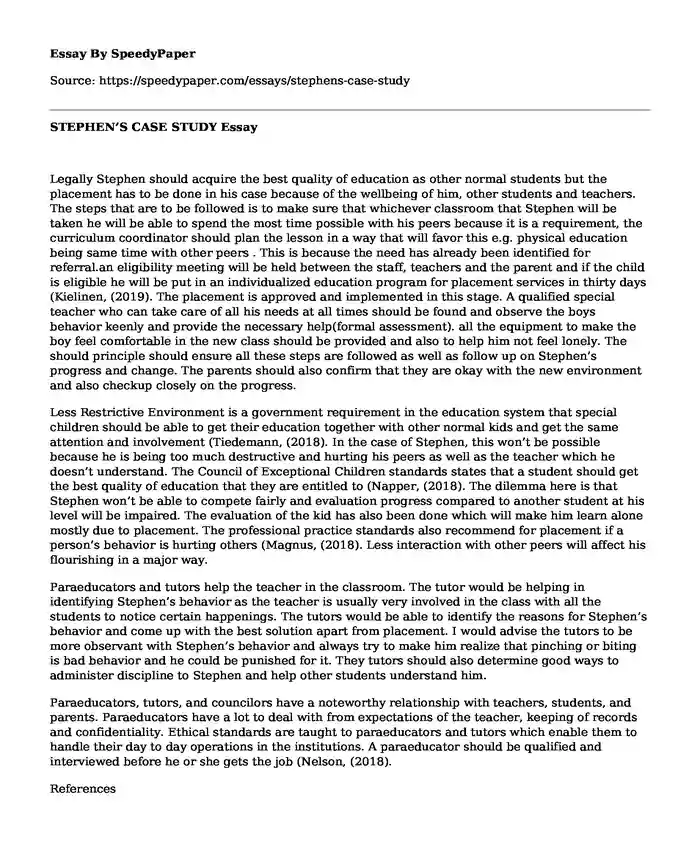
| Type of paper: | Essay |
| Categories: | Company Nursing Technology |
| Pages: | 3 |
| Wordcount: | 726 words |
Legally Stephen should acquire the best quality of education as other normal students but the placement has to be done in his case because of the wellbeing of him, other students and teachers. The steps that are to be followed is to make sure that whichever classroom that Stephen will be taken he will be able to spend the most time possible with his peers because it is a requirement, the curriculum coordinator should plan the lesson in a way that will favor this e.g. physical education being same time with other peers . This is because the need has already been identified for referral.an eligibility meeting will be held between the staff, teachers and the parent and if the child is eligible he will be put in an individualized education program for placement services in thirty days (Kielinen, (2019). The placement is approved and implemented in this stage. A qualified special teacher who can take care of all his needs at all times should be found and observe the boys behavior keenly and provide the necessary help(formal assessment). all the equipment to make the boy feel comfortable in the new class should be provided and also to help him not feel lonely. The should principle should ensure all these steps are followed as well as follow up on Stephen's progress and change. The parents should also confirm that they are okay with the new environment and also checkup closely on the progress.
Less Restrictive Environment is a government requirement in the education system that special children should be able to get their education together with other normal kids and get the same attention and involvement (Tiedemann, (2018). In the case of Stephen, this won't be possible because he is being too much destructive and hurting his peers as well as the teacher which he doesn't understand. The Council of Exceptional Children standards states that a student should get the best quality of education that they are entitled to (Napper, (2018). The dilemma here is that Stephen won't be able to compete fairly and evaluation progress compared to another student at his level will be impaired. The evaluation of the kid has also been done which will make him learn alone mostly due to placement. The professional practice standards also recommend for placement if a person's behavior is hurting others (Magnus, (2018). Less interaction with other peers will affect his flourishing in a major way.
Paraeducators and tutors help the teacher in the classroom. The tutor would be helping in identifying Stephen's behavior as the teacher is usually very involved in the class with all the students to notice certain happenings. The tutors would be able to identify the reasons for Stephen's behavior and come up with the best solution apart from placement. I would advise the tutors to be more observant with Stephen's behavior and always try to make him realize that pinching or biting is bad behavior and he could be punished for it. They tutors should also determine good ways to administer discipline to Stephen and help other students understand him.
Paraeducators, tutors, and councilors have a noteworthy relationship with teachers, students, and parents. Paraeducators have a lot to deal with from expectations of the teacher, keeping of records and confidentiality. Ethical standards are taught to paraeducators and tutors which enable them to handle their day to day operations in the institutions. A paraeducator should be qualified and interviewed before he or she gets the job (Nelson, (2018).
References
Dawson, S. A., & Napper, V. S. (2018). The Confluence Effect of Policy, Mental Models, and Ethics on Individual Behavior. Learning, Design, and Technology: An International Compendium of Theory, Research, Practice, and Policy, 1-13.
Lakkala, S., Takala, M., Miettunen, H., Kyro-Ammala, O., Sarivaara, E., & Kielinen, M. (2019). Steps towards and challenges of inclusive education in Northern Finland. Including the North: a comparative study of the policies on inclusion and equity in the Circumpolar North.
Langorgen, E., Kermit, P., & Magnus, E. (2018). Gatekeeping in professional higher education in Norway: Ambivalence among academic staff and placement supervisors towards students with disabilities. International Journal of Inclusive Education, 1-15.
Tiedemann, R. K. (2018). The Design and Development of a Transitional Classroom for Students with Autism Spectrum Disorder (Doctoral dissertation, Wilmington University (Delaware)).
Wines, L. A., & Nelson, J. A. (Eds.). (2018). School Counselors as Practitioners: Building on Theory, Standards, and Experience for Optimal Performance. Routledge.
Cite this page
STEPHEN'S CASE STUDY. (2022, Dec 30). Retrieved from https://speedypaper.com/essays/stephens-case-study
Request Removal
If you are the original author of this essay and no longer wish to have it published on the SpeedyPaper website, please click below to request its removal:
- Free Essay on Advanced Risk and Uncertainty Management
- Essay Sample: Wage-Labor and Capital According to Karl Marx
- Free Essay Summary of the Book The Prince
- Short Independent Research ProjectIntroduction
- Free Essay Example: Business Analytics in CRM
- Essay Sample on Change in Field of Nursing
- Research Paper on Cognitive Behavioral Therapy As an Effective Treatment for Anxiety in a School Setting
Popular categories




